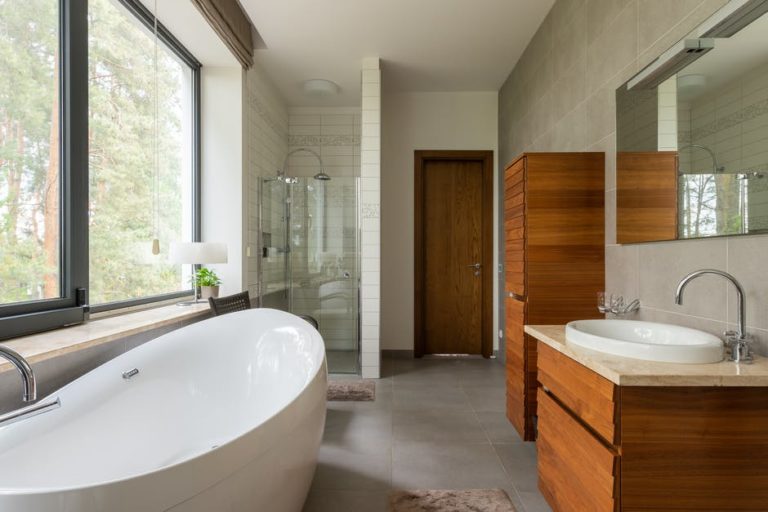
How to Plan Your Bathroom Remodel: A Step-by-Step Guide
Embarking on a bathroom remodel can be both exciting and daunting. A well-planned renovation not only enhances the comfort and aesthetic appeal of your home but also adds value. This guide takes you through each step of the process, ensuring your bathroom remodel is a success from start to finish.
Step 1: Define Your Vision and Goals
Embarking on a bathroom remodel starts with a clear understanding of what you want to achieve. Defining your vision and goals sets the foundation for a successful renovation. Let’s delve deeper into what this entails and the various aspects to consider.
Identifying Remodeling Goals
Your goals for a bathroom remodel might vary depending on your lifestyle, preferences, and the current state of your bathroom. Common remodeling goals include:
- Updating the Look: If your bathroom feels outdated, your goal might be a more modern, sleek, and contemporary look. This could involve updating fixtures, cabinetry, and tiles.
- Improving Functionality: For bathrooms that don’t meet your functional needs, consider a layout change, additional storage solutions, or updating fixtures to improve usability.
- Increasing Home Value: If you’re remodeling with resale in mind, focus on updates that offer a good return on investment, such as high-quality tiles, a double vanity, or a walk-in shower.
- Enhancing Comfort and Luxury: Some remodels aim to create a spa-like, luxurious bathroom experience, with features like a freestanding tub, heated floors, or high-end finishes.
- Making the Space More Efficient: This can include water-saving toilets, LED lighting, or energy-efficient ventilation systems.
Considerations for Replacing or Upgrading
When planning your remodel, assess what needs to be replaced or upgraded. Key considerations might include:
- Fixtures and Fittings: Old or worn-out fixtures like faucets, showerheads, and toilets can be replaced with modern, efficient models. Consider the style and finish of these fixtures to complement your overall design.
- Tiles and Flooring: Evaluate if your current tiles are dated, damaged, or unsuitable for your new design. New tiling can dramatically change the look and feel of the bathroom.
- Cabinetry and Storage: Think about whether your current storage solutions are adequate. Upgrading or adding cabinetry can enhance both the functionality and aesthetics of the space.
- Lighting: Adequate and well-placed lighting is crucial in a bathroom. Consider layered lighting with a mix of task, ambient, and accent lights.
- Ventilation: Proper ventilation is essential in a bathroom to prevent mold and moisture damage. Upgrading your ventilation system can improve air quality and protect your renovation investments.
- Bath or Shower: Decide whether to replace your current bathtub or shower. Consider space, usage preferences, and the potential for a tub-to-shower conversion if it aligns with your needs.

Understanding Your Needs and Preferences
Begin by defining what you want to achieve with your bathroom remodel. Consider aspects like:
- Functionality: Do you need more storage, better lighting, or a more efficient layout?
- Style: Are you aiming for a modern look, a traditional feel, or something unique?
- Special Features: Think about elements like a walk-in shower, a soaking tub, or heated floors.
Gathering Inspiration
Use resources like home improvement magazines, websites, and social media platforms for inspiration. Create a mood board or a collection of images that reflect your desired bathroom style.
Defining your vision and goals for a bathroom remodel is about balancing aesthetics, functionality, and budget. Consider not just how you want the bathroom to look, but also how it will be used and what improvements will add the most value. Being clear about your remodeling objectives from the start will guide your decisions and help ensure that the final result aligns with your vision for the space.
Step 2: Set a Budget
A crucial step in any bathroom remodeling project is establishing a budget that reflects your goals while remaining realistic about the costs involved. Understanding the financial aspect of a bathroom remodel can help you make informed decisions and avoid unexpected expenses.
Understanding Average Remodel Costs
The cost of a bathroom remodel can vary widely based on factors like the size of the bathroom, the extent of the renovations, the quality of materials, and regional labor rates. On average, bathroom remodels can range from a few thousand dollars for minor updates to tens of thousands for high-end, luxury renovations.
Determining your budget early on is crucial. Consider:
- Costs of Materials: Tiles, fixtures, and finishes can vary widely in price.
- Labor Costs: Professional services like plumbing, electrical work, and installation.
- Contingency Fund: Set aside an additional 10-20% of your budget for unexpected expenses.
Breakdown of Different Bathroom Projects
The cost of your bathroom remodel will depend largely on the scope and scale of your project:
- Minor Updates: This may include painting, updating fixtures, or replacing mirrors. Such projects are usually less costly, ranging from $1,000 to $5,000.
- Moderate Renovations: For projects involving more significant changes like new tiling, replacing a vanity, or updating a shower, costs can range from $5,000 to $15,000.
- Major Overhauls: These encompass full-scale renovations, possibly changing the entire layout, installing high-end fixtures, or adding luxury features. Such projects can easily exceed $15,000, with some high-end remodels reaching $30,000 or more.

Factors Influencing Remodel Costs
Several elements contribute to the overall cost of a bathroom remodel:
- Material Quality: Higher-end materials like natural stone tiles or premium fixtures will significantly increase costs compared to standard materials.
- Labor Expenses: Skilled labor for plumbing, electrical work, and installation is a substantial portion of the budget. Labor costs can be influenced by the complexity of the work and regional rates.
- Structural Changes: Any structural alterations, like moving walls or plumbing, add to the cost due to the additional labor and materials required.
- Unforeseen Issues: Always account for unexpected issues, such as water damage or outdated wiring, especially in older homes. These can increase costs unexpectedly.
Planning Your Budget
To plan your budget effectively:
- Prioritize Your Needs: Focus on what’s most important to you, whether it’s updating the shower, expanding storage, or improving lighting.
- Get Multiple Quotes: Obtain quotes from several contractors to gauge a realistic price range for your project.
- Include a Contingency Fund: Set aside an extra 10-20% of your budget for unforeseen expenses.
Financing Your Remodel
Consider your options for financing the remodel:
- Savings: Using personal savings is the most straightforward option, avoiding interest and debt.
- Home Equity Loans or Lines of Credit: These can be viable options if you have equity in your home.
- Personal Loans or Credit Cards: These may be suitable for smaller projects but come with higher interest rates.
Establishing a realistic budget for your bathroom remodel requires careful consideration of your goals, an understanding of the costs associated with different types of projects, and a plan to finance the renovation. By thoroughly researching and planning your budget, you can ensure that your bathroom remodel is both financially feasible and aligned with your vision.

Step 3: Measure and Plan the Layout
Careful measurement and thoughtful planning of the layout are critical steps in a bathroom remodel. These early stages lay the groundwork for a successful renovation, ensuring that the final design is both functional and aesthetically pleasing. Let’s explore how to effectively measure and plan your bathroom layout.
The Importance of Accurate Measurements
Precise measurements are the foundation of any remodeling project. They are essential for:
- Space Utilization: Understanding the exact dimensions of your bathroom helps in effectively planning the placement of fixtures and features.
- Material Estimates: Accurate measurements are necessary for estimating the amount of materials needed, such as tiles, flooring, and paint.
- Fitting Fixtures: Ensuring that new fixtures like sinks, toilets, and showers will fit comfortably and functionally into the space.
Conducting the Measurements
When measuring your bathroom:
- Dimensional Layout: Measure the length, width, and height of the room. Include doorways, windows, and any existing fixtures.
- Note Obstructions: Consider any existing features that might impact the remodel, such as radiators, pipes, or built-in cabinets.
- Utilize Graph Paper or Design Software: Creating a scaled drawing on graph paper or using design software can help visualize the space and plan more effectively.
Planning the Bathroom Layout
In planning your new bathroom layout:
- Functional Zones: Consider dividing the bathroom into distinct functional zones – bathing/showering, vanity, and toilet areas.
- Traffic Flow: Ensure there is enough space for comfortable movement and access to each area of the bathroom.
- Ventilation and Lighting: Plan for adequate ventilation and natural or artificial lighting in your layout.
Design Considerations
- Aesthetics and Style: Your layout should complement the overall design theme you have chosen for your bathroom.
- Storage Solutions: Incorporate sufficient storage into your layout, considering options like built-in cabinets, shelves, or vanity storage.
- Accessibility and Safety: For households with elderly or disabled members, consider incorporating accessibility features into your layout.
Working with Professionals
While some homeowners may have the skills to plan and execute a bathroom remodel independently, working with a professional can offer significant advantages:
- Expert Insight: Designers and architects can provide creative solutions to maximize space and functionality.
- Technical Know-How: Professionals can help navigate complex issues like plumbing and electrical layouts.
- Avoiding Mistakes: Expert input can prevent costly errors in the planning and execution phases.
Measuring and planning the layout of your bathroom remodel is a step that should not be underestimated. It requires careful consideration of both practical and aesthetic elements to ensure a successful transformation of your bathroom space.

Step 4: Choose Materials and Finishes
The choice of materials and finishes is a crucial element in any bathroom remodeling project. It’s not just about the look; these decisions affect the long-term functionality and maintenance of your bathroom. Here we explore common options for materials and finishes to help guide your selection process.
Tile Choices for Flooring and Walls
Tiles are a staple in bathroom design, offering durability and versatility. Ceramic and porcelain tiles stand out for their wide range of designs, suitable for both floors and walls. They are practical, easy to clean, and come in various sizes and colors. Natural stone tiles like marble, granite, or slate add a touch of luxury and unique patterns, though they might require more maintenance to preserve their beauty.
Countertop Materials
The countertop is often a focal point in bathroom design. Materials like granite and quartz are favorites for their durability and minimal maintenance. They come in an array of colors and patterns, providing versatility in design. Solid surface materials offer a modern look with seamless installation, available in a multitude of colors to fit any design theme.
Fixtures and Hardware Details
Fixtures and hardware may seem like small details, but they significantly influence the bathroom’s style and functionality. Faucets and showerheads now come in various finishes such as chrome, brushed nickel, and matte black, allowing for customization to your style. Cabinetry hardware like pulls and knobs are the finishing touches that can enhance the overall aesthetic of the bathroom.
Flooring Alternatives Beyond Tiles
While tiles are a popular choice for bathroom floors, alternatives like vinyl flooring and engineered wood offer different aesthetics and benefits. Vinyl flooring is a cost-effective option that comes in designs mimicking wood or stone and is known for its durability and water resistance. Engineered wood provides the warmth and look of natural wood while being more suitable for the moist environment of a bathroom.
Lighting and Accessories for Ambiance and Functionality
The right lighting can transform a bathroom space. A combination of overhead, task, and accent lighting creates a functional yet relaxing atmosphere. Mirrors play a dual role in functionality and style, with options ranging from basic designs to statement pieces. Adding accessories like towel racks, shower curtains, and decorative elements personalizes the space, making it truly yours.
Choosing the right materials and finishes for your bathroom remodel involves balancing aesthetic desires with practical considerations. Every choice, from the type of tile to the bathroom fixtures, contributes to creating a space that is not only visually appealing but also suits your lifestyle and needs. Careful selection ensures that the remodeled bathroom will be a space of comfort and utility for years to come.

Step 5: Find a Contractor
Hiring Professionals
Finding the right contractor is critical:
- Research and Referrals: Look for reputable contractors with experience in bathroom renovations. Check online reviews and ask for referrals.
- Quotes and Estimates: Get detailed quotes from multiple contractors.
- Credentials and Portfolio: Verify their credentials and ask to see their portfolio of past projects.
Step 6: Create a Timeline and Prepare for the Remodel
A well-planned timeline is crucial for a smooth and successful bathroom remodeling project. Understanding the time frame for various stages of the remodel helps in setting realistic expectations and minimizes disruptions in your daily life.
The Initial Planning Phase
The planning stage is where you set the foundation for your remodel. This involves defining your project’s scope, selecting materials, and finalizing the design. Allow several weeks to a month for this phase, especially if you are working with a designer or architect. This time is crucial for thorough decision-making and avoiding rushed choices.
Hiring Contractors and Scheduling
Once your plan is in place, the next step is to hire contractors. Depending on their availability and your project’s complexity, it might take a few weeks to start the work. Seasonal demand can also affect this timeline. Ensure you discuss and agree on a realistic start date and project duration with your contractor.
The Demolition and Structural Work
The actual construction begins with demolition, followed by any structural changes like moving walls or altering plumbing. This phase can take a few days to a couple of weeks, depending on the extent of the changes. It’s one of the most disruptive stages, so prepare for some inconvenience during this period.
Installation of New Features
Following structural adjustments, new installations such as tiles, fixtures, and cabinetry begin. This stage can vary significantly in duration, from a week to several weeks, based on the complexity of the installations and the availability of materials.
Finishing Touches and Finalization
The final phase includes painting, installing light fixtures, and adding the finishing touches. This stage generally takes about a week, concluding with a thorough cleaning and the final walkthrough. During the final walkthrough, review the work with your contractor and address any adjustments or corrections.
Allow Buffer Time
It’s wise to include a buffer in your timeline for unforeseen delays, which are not uncommon in remodeling projects. Issues like backordered materials, unexpected structural problems, or changes to the project scope can extend the timeline.
Communicating with Your Contractor
Maintain open communication with your contractor throughout the project. Regular updates can help you stay informed about the progress and any changes in the timeline.
Setting a realistic timeline for your bathroom remodel is about understanding the sequence of work and accounting for both expected and unexpected factors. A well-planned timeline ensures that the project progresses smoothly and helps in managing the temporary disruption to your home life. Remember, flexibility and patience are key, as remodels can often bring surprises along the way.

Step 7: Oversee the Remodeling Process
Managing the Project
Stay involved and monitor the progress:
- Regular Check-ins: Keep in touch with your contractor for updates.
- Addressing Issues: Promptly discuss any concerns or issues that arise.
- Quality Checks: Ensure work is being completed to your satisfaction.
Step 8: Final Inspection and Touch-ups
Wrapping Up
Once the main work is completed:
- Inspect the Work: Go through a final walkthrough with your contractor to identify any outstanding issues or touch-ups.
- Settle Payments: Complete all payments once you are satisfied with the work.
Planning and executing a bathroom remodel requires careful consideration and effective project management. By following these steps, you can transform your bathroom into a space that meets your needs, reflects your style, and adds value to your home. Remember, a successful remodel is a balance of aesthetics, functionality, and budget management.

